dashboard Lancia Musa 2010 Owner handbook (in English)
[x] Cancel search | Manufacturer: LANCIA, Model Year: 2010, Model line: Musa, Model: Lancia Musa 2010Pages: 218, PDF Size: 3.71 MB
Page 138 of 218
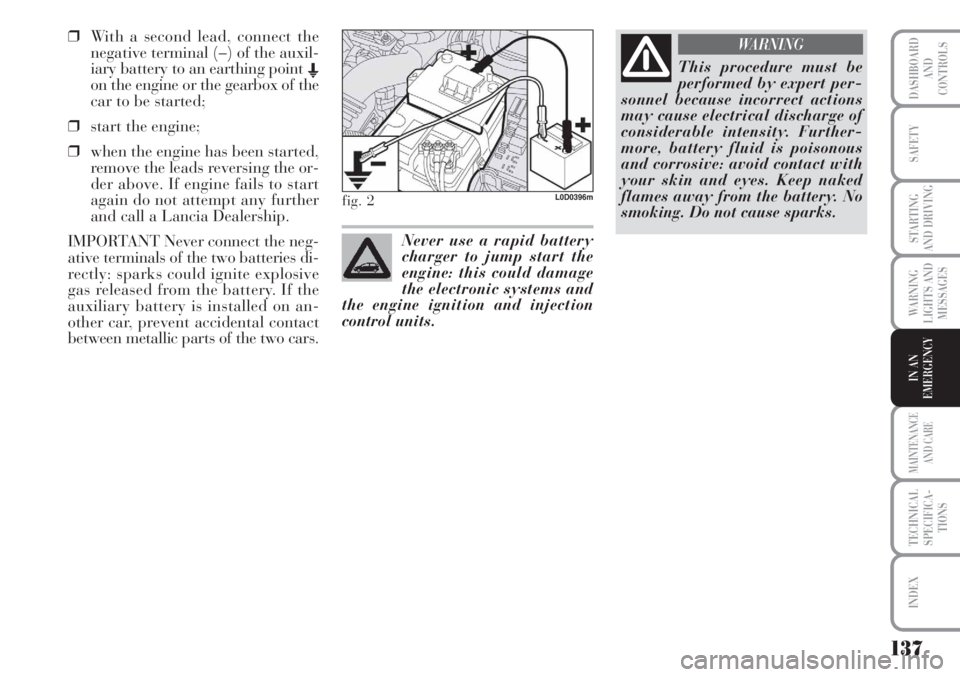
137
WARNING
LIGHTS AND
MESSAGES
MAINTENANCE
AND CARE
TECHNICAL
SPECIFICA-
TIONS
INDEX
DASHBOARD
AND
CONTROLS
SAFETY
STARTING
AND DRIVING
IN AN
EMERGENCY
❒With a second lead, connect the
negative terminal (–) of the auxil-
iary battery to an earthing point E
on the engine or the gearbox of the
car to be started;
❒start the engine;
❒when the engine has been started,
remove the leads reversing the or-
der above. If engine fails to start
again do not attempt any further
and call a Lancia Dealership.
IMPORTANT Never connect the neg-
ative terminals of the two batteries di-
rectly: sparks could ignite explosive
gas released from the battery. If the
auxiliary battery is installed on an-
other car, prevent accidental contact
between metallic parts of the two cars.
fig. 2L0D0396m
This procedure must be
performed by expert per-
sonnel because incorrect actions
may cause electrical discharge of
considerable intensity. Further-
more, battery fluid is poisonous
and corrosive: avoid contact with
your skin and eyes. Keep naked
flames away from the battery. No
smoking. Do not cause sparks.
WARNING
Never use a rapid battery
charger to jump start the
engine: this could damage
the electronic systems and
the engine ignition and injection
control units.
Page 139 of 218
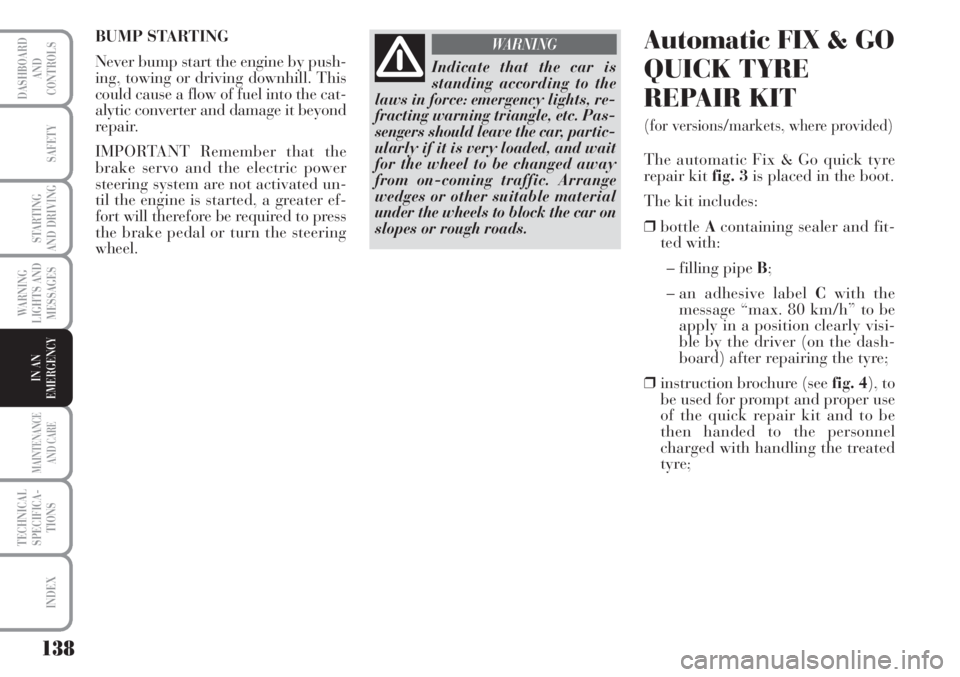
138
WARNING
LIGHTS AND
MESSAGES
MAINTENANCE
AND CARE
TECHNICAL
SPECIFICA-
TIONS
INDEX
DASHBOARD
AND
CONTROLS
SAFETY
STARTING
AND DRIVING
IN AN
EMERGENCY
BUMP STARTING
Never bump start the engine by push-
ing, towing or driving downhill. This
could cause a flow of fuel into the cat-
alytic converter and damage it beyond
repair.
IMPORTANT Remember that the
brake servo and the electric power
steering system are not activated un-
til the engine is started, a greater ef-
fort will therefore be required to press
the brake pedal or turn the steering
wheel.
Indicate that the car is
standing according to the
laws in force: emergency lights, re-
fracting warning triangle, etc. Pas-
sengers should leave the car, partic-
ularly if it is very loaded, and wait
for the wheel to be changed away
from on-coming traffic. Arrange
wedges or other suitable material
under the wheels to block the car on
slopes or rough roads.
WARNINGAutomatic FIX & GO
QUICK TYRE
REPAIR KIT
(for versions/markets, where provided)
The automatic Fix & Go quick tyre
repair kit fig. 3is placed in the boot.
The kit includes:
❒bottleAcontaining sealer and fit-
ted with:
– filling pipe B;
– an adhesive label Cwith the
message “max. 80 km/h” to be
apply in a position clearly visi-
ble by the driver (on the dash-
board) after repairing the tyre;
❒instruction brochure (see fig. 4), to
be used for prompt and proper use
of the quick repair kit and to be
then handed to the personnel
charged with handling the treated
tyre;
Page 140 of 218
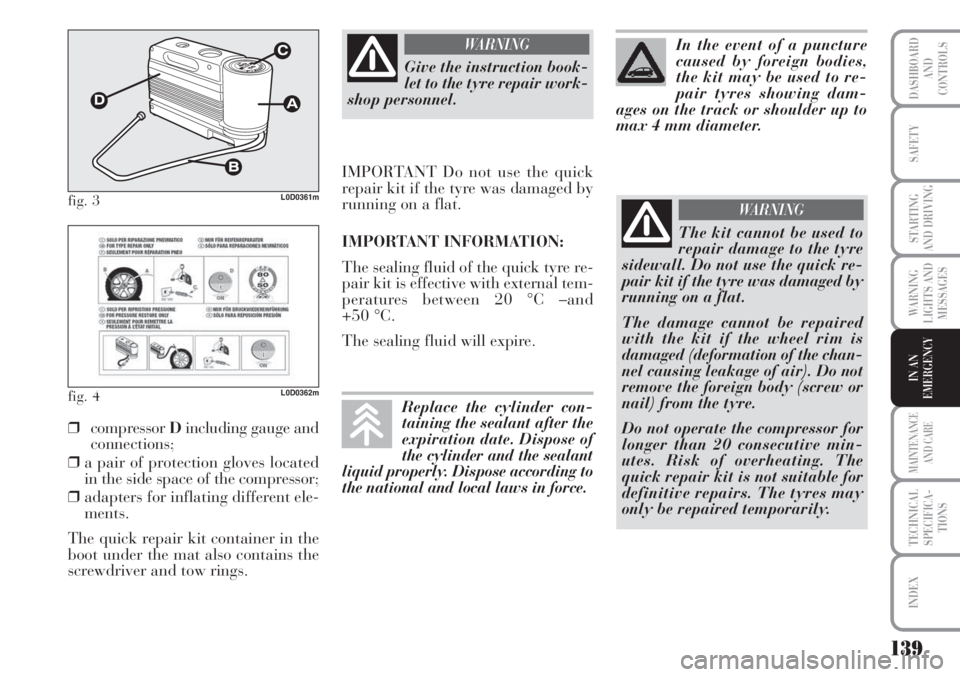
139
WARNING
LIGHTS AND
MESSAGES
MAINTENANCE
AND CARE
TECHNICAL
SPECIFICA-
TIONS
INDEX
DASHBOARD
AND
CONTROLS
SAFETY
STARTING
AND DRIVING
IN AN
EMERGENCY
fig. 3L0D0361m
fig. 4L0D0362m
❒compressor Dincluding gauge and
connections;
❒a pair of protection gloves located
in the side space of the compressor;
❒adapters for inflating different ele-
ments.
The quick repair kit container in the
boot under the mat also contains the
screwdriver and tow rings.
Give the instruction book-
let to the tyre repair work-
shop personnel.
WARNING
IMPORTANT Do not use the quick
repair kit if the tyre was damaged by
running on a flat.
IMPORTANT INFORMATION:
The sealing fluid of the quick tyre re-
pair kit is effective with external tem-
peratures between 20 °C –and
+50 °C.
The sealing fluid will expire.
The kit cannot be used to
repair damage to the tyre
sidewall. Do not use the quick re-
pair kit if the tyre was damaged by
running on a flat.
The damage cannot be repaired
with the kit if the wheel rim is
damaged (deformation of the chan-
nel causing leakage of air). Do not
remove the foreign body (screw or
nail) from the tyre.
Do not operate the compressor for
longer than 20 consecutive min-
utes. Risk of overheating. The
quick repair kit is not suitable for
definitive repairs. The tyres may
only be repaired temporarily.
WARNING
In the event of a puncture
caused by foreign bodies,
the kit may be used to re-
pair tyres showing dam-
ages on the track or shoulder up to
max 4 mm diameter.
Replace the cylinder con-
taining the sealant after the
expiration date. Dispose of
the cylinder and the sealant
liquid properly. Dispose according to
the national and local laws in force.
Page 141 of 218
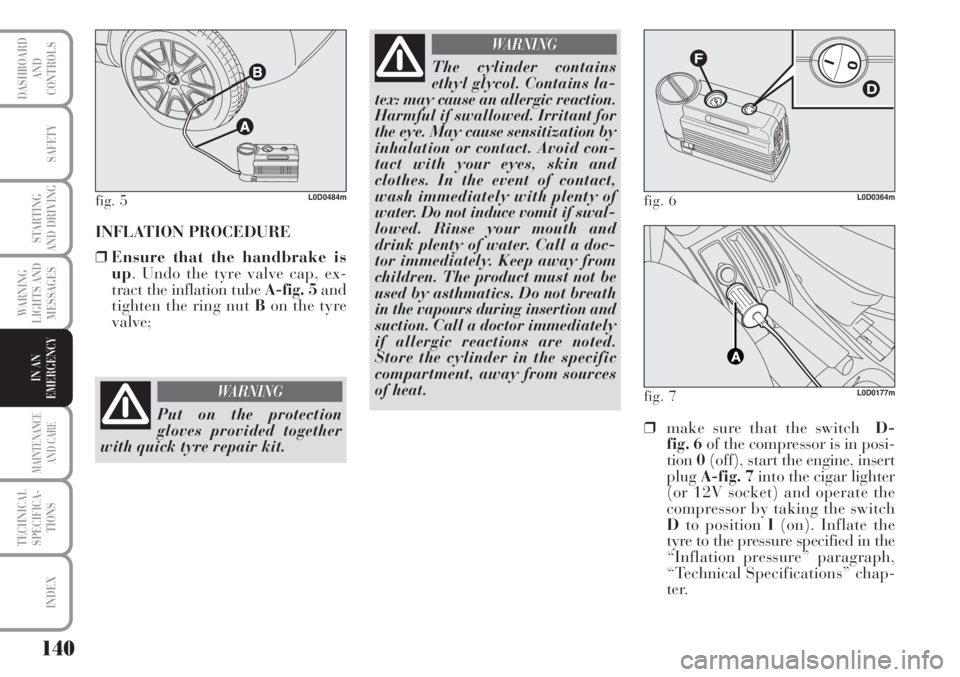
140
WARNING
LIGHTS AND
MESSAGES
MAINTENANCE
AND CARE
TECHNICAL
SPECIFICA-
TIONS
INDEX
DASHBOARD
AND
CONTROLS
SAFETY
STARTING
AND DRIVING
IN AN
EMERGENCY
INFLATION PROCEDURE
❒Ensure that the handbrake is
up. Undo the tyre valve cap, ex-
tract the inflation tube A-fig. 5and
tighten the ring nut Bon the tyre
valve;
fig. 5L0D0484m
Put on the protection
gloves provided together
with quick tyre repair kit.
WARNING
The cylinder contains
ethyl glycol. Contains la-
tex: may cause an allergic reaction.
Harmful if swallowed. Irritant for
the eye. May cause sensitization by
inhalation or contact. Avoid con-
tact with your eyes, skin and
clothes. In the event of contact,
wash immediately with plenty of
water. Do not induce vomit if swal-
lowed. Rinse your mouth and
drink plenty of water. Call a doc-
tor immediately. Keep away from
children. The product must not be
used by asthmatics. Do not breath
in the vapours during insertion and
suction. Call a doctor immediately
if allergic reactions are noted.
Store the cylinder in the specific
compartment, away from sources
of heat.
WARNING
❒make sure that the switch D-
fig. 6of the compressor is in posi-
tion0(off), start the engine, insert
plugA-fig. 7into the cigar lighter
(or 12V socket) and operate the
compressor by taking the switch
Dto position I(on). Inflate the
tyre to the pressure specified in the
“Inflation pressure” paragraph,
“Technical Specifications” chap-
ter.
fig. 6L0D0364m
fig. 7L0D0177m
Page 142 of 218
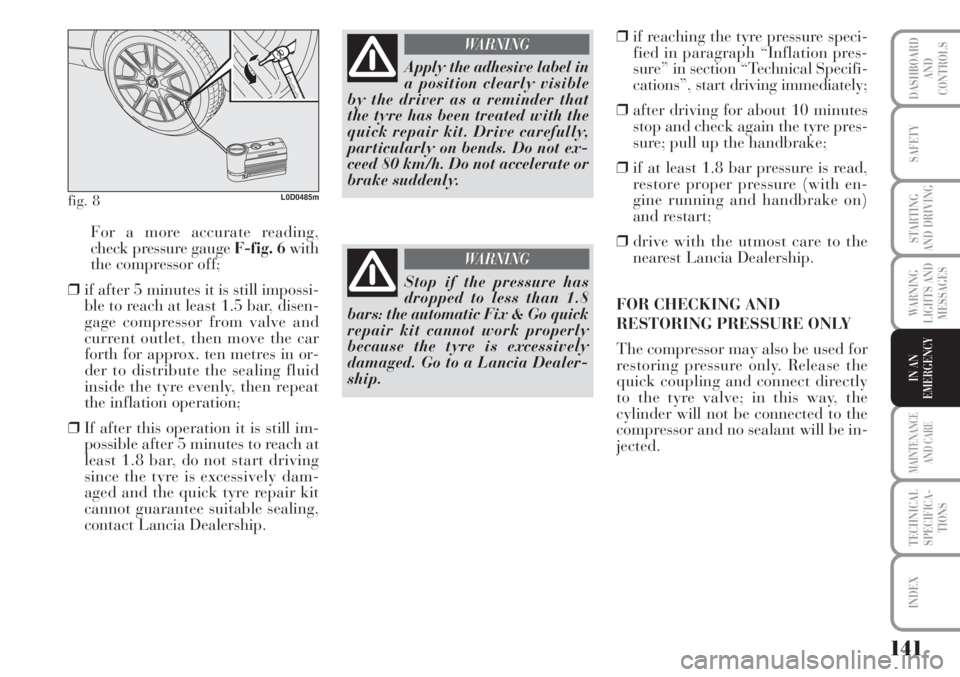
141
WARNING
LIGHTS AND
MESSAGES
MAINTENANCE
AND CARE
TECHNICAL
SPECIFICA-
TIONS
INDEX
DASHBOARD
AND
CONTROLS
SAFETY
STARTING
AND DRIVING
IN AN
EMERGENCY
For a more accurate reading,
check pressure gauge F-fig. 6with
the compressor off;
❒if after 5 minutes it is still impossi-
ble to reach at least 1.5 bar, disen-
gage compressor from valve and
current outlet, then move the car
forth for approx. ten metres in or-
der to distribute the sealing fluid
inside the tyre evenly, then repeat
the inflation operation;
❒If after this operation it is still im-
possible after 5 minutes to reach at
least 1.8 bar, do not start driving
since the tyre is excessively dam-
aged and the quick tyre repair kit
cannot guarantee suitable sealing,
contact Lancia Dealership.
fig. 8L0D0485m
Apply the adhesive label in
a position clearly visible
by the driver as a reminder that
the tyre has been treated with the
quick repair kit. Drive carefully,
particularly on bends. Do not ex-
ceed 80 km/h. Do not accelerate or
brake suddenly.
WARNING
Stop if the pressure has
dropped to less than 1.8
bars: the automatic Fix & Go quick
repair kit cannot work properly
because the tyre is excessively
damaged. Go to a Lancia Dealer-
ship.
WARNING
❒if reaching the tyre pressure speci-
fied in paragraph “Inflation pres-
sure” in section “Technical Specifi-
cations”, start driving immediately;
❒after driving for about 10 minutes
stop and check again the tyre pres-
sure; pull up the handbrake;
❒if at least 1.8 bar pressure is read,
restore proper pressure (with en-
gine running and handbrake on)
and restart;
❒drive with the utmost care to the
nearest Lancia Dealership.
FOR CHECKING AND
RESTORING PRESSURE ONLY
The compressor may also be used for
restoring pressure only. Release the
quick coupling and connect directly
to the tyre valve; in this way, the
cylinder will not be connected to the
compressor and no sealant will be in-
jected.
Page 143 of 218
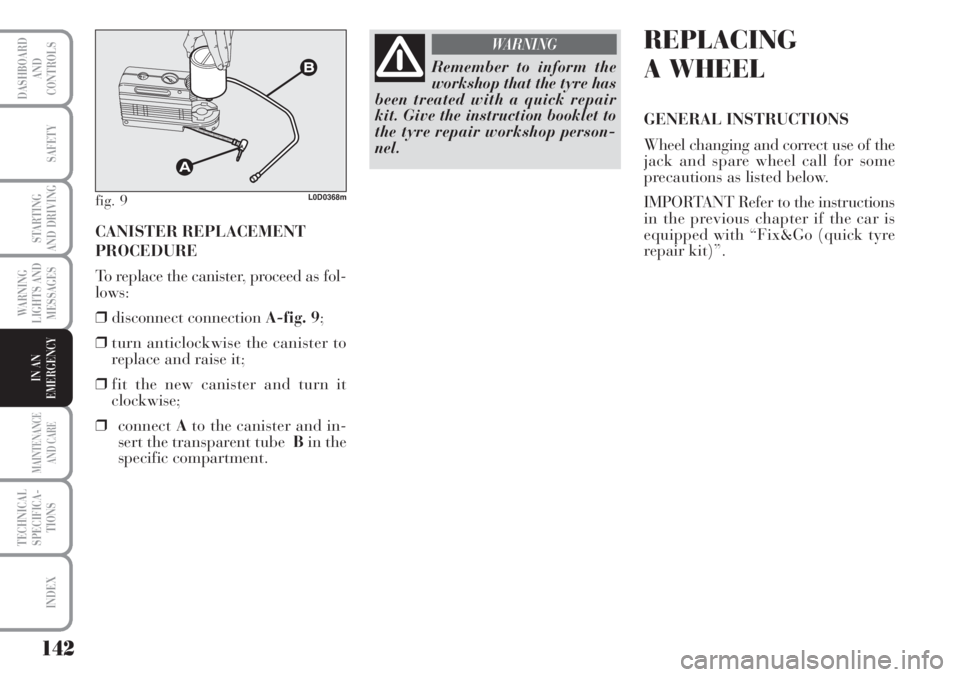
142
WARNING
LIGHTS AND
MESSAGES
MAINTENANCE
AND CARE
TECHNICAL
SPECIFICA-
TIONS
INDEX
DASHBOARD
AND
CONTROLS
SAFETY
STARTING
AND DRIVING
IN AN
EMERGENCY
CANISTER REPLACEMENT
PROCEDURE
To replace the canister, proceed as fol-
lows:
❒disconnect connection A-fig. 9;
❒turn anticlockwise the canister to
replace and raise it;
❒fit the new canister and turn it
clockwise;
❒connectAto the canister and in-
sert the transparent tube Bin the
specific compartment.
fig. 9L0D0368m
Remember to inform the
workshop that the tyre has
been treated with a quick repair
kit. Give the instruction booklet to
the tyre repair workshop person-
nel.
WARNINGREPLACING
A WHEEL
GENERAL INSTRUCTIONS
Wheel changing and correct use of the
jack and spare wheel call for some
precautions as listed below.
IMPORTANT Refer to the instructions
in the previous chapter if the car is
equipped with “Fix&Go (quick tyre
repair kit)”.
Page 144 of 218
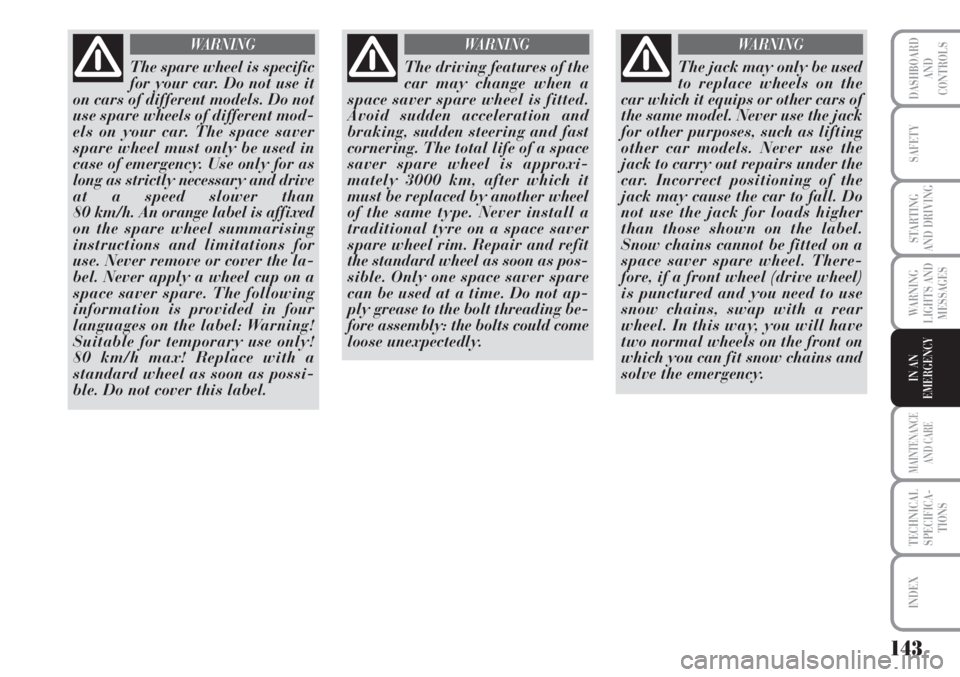
143
WARNING
LIGHTS AND
MESSAGES
MAINTENANCE
AND CARE
TECHNICAL
SPECIFICA-
TIONS
INDEX
DASHBOARD
AND
CONTROLS
SAFETY
STARTING
AND DRIVING
IN AN
EMERGENCY
The spare wheel is specific
for your car. Do not use it
on cars of different models. Do not
use spare wheels of different mod-
els on your car. The space saver
spare wheel must only be used in
case of emergency. Use only for as
long as strictly necessary and drive
at a speed slower than
80 km/h. An orange label is affixed
on the spare wheel summarising
instructions and limitations for
use. Never remove or cover the la-
bel. Never apply a wheel cup on a
space saver spare. The following
information is provided in four
languages on the label: Warning!
Suitable for temporary use only!
80 km/h max! Replace with a
standard wheel as soon as possi-
ble. Do not cover this label.
WARNING
The driving features of the
car may change when a
space saver spare wheel is fitted.
Avoid sudden acceleration and
braking, sudden steering and fast
cornering. The total life of a space
saver spare wheel is approxi-
mately 3000 km, after which it
must be replaced by another wheel
of the same type. Never install a
traditional tyre on a space saver
spare wheel rim. Repair and refit
the standard wheel as soon as pos-
sible. Only one space saver spare
can be used at a time. Do not ap-
ply grease to the bolt threading be-
fore assembly: the bolts could come
loose unexpectedly.
WARNING
The jack may only be used
to replace wheels on the
car which it equips or other cars of
the same model. Never use the jack
for other purposes, such as lifting
other car models. Never use the
jack to carry out repairs under the
car. Incorrect positioning of the
jack may cause the car to fall. Do
not use the jack for loads higher
than those shown on the label.
Snow chains cannot be fitted on a
space saver spare wheel. There-
fore, if a front wheel (drive wheel)
is punctured and you need to use
snow chains, swap with a rear
wheel. In this way, you will have
two normal wheels on the front on
which you can fit snow chains and
solve the emergency.
WARNING
Page 145 of 218
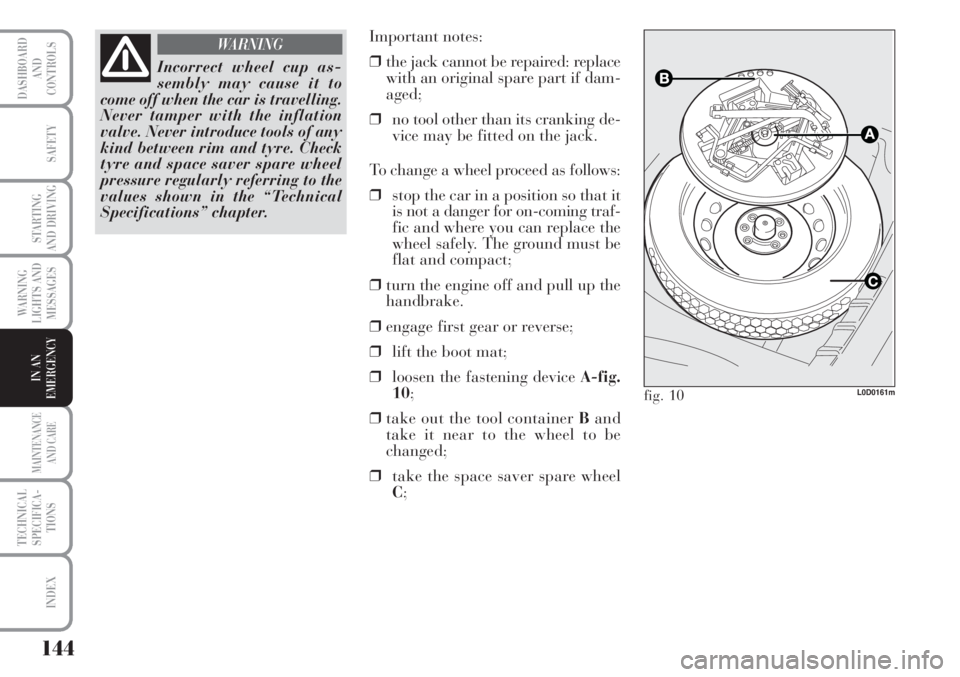
144
WARNING
LIGHTS AND
MESSAGES
MAINTENANCE
AND CARE
TECHNICAL
SPECIFICA-
TIONS
INDEX
DASHBOARD
AND
CONTROLS
SAFETY
STARTING
AND DRIVING
IN AN
EMERGENCY
Incorrect wheel cup as-
sembly may cause it to
come off when the car is travelling.
Never tamper with the inflation
valve. Never introduce tools of any
kind between rim and tyre. Check
tyre and space saver spare wheel
pressure regularly referring to the
values shown in the “Technical
Specifications” chapter.
WARNINGImportant notes:
❒the jack cannot be repaired: replace
with an original spare part if dam-
aged;
❒no tool other than its cranking de-
vice may be fitted on the jack.
To change a wheel proceed as follows:
❒stop the car in a position so that it
is not a danger for on-coming traf-
fic and where you can replace the
wheel safely. The ground must be
flat and compact;
❒turn the engine off and pull up the
handbrake.
❒engage first gear or reverse;
❒lift the boot mat;
❒loosen the fastening device A-fig.
10;
❒take out the tool container Band
take it near to the wheel to be
changed;
❒take the space saver spare wheel
C;
L0D0161mfig. 10
Page 146 of 218
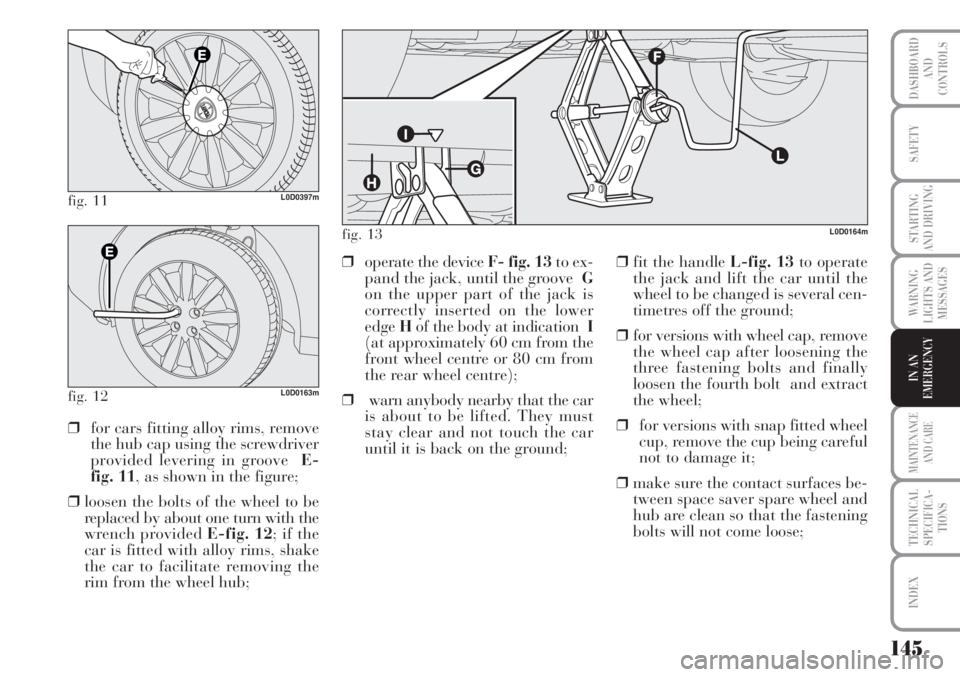
145
WARNING
LIGHTS AND
MESSAGES
MAINTENANCE
AND CARE
TECHNICAL
SPECIFICA-
TIONS
INDEX
DASHBOARD
AND
CONTROLS
SAFETY
STARTING
AND DRIVING
IN AN
EMERGENCY
fig. 11L0D0397m
fig. 12L0D0163m
❒for cars fitting alloy rims, remove
the hub cap using the screwdriver
provided levering in groove E-
fig. 11, as shown in the figure;
❒loosen the bolts of the wheel to be
replaced by about one turn with the
wrench provided E-fig. 12; if the
car is fitted with alloy rims, shake
the car to facilitate removing the
rim from the wheel hub;❒operate the device F- fig. 13to ex-
pand the jack, until the groove G
on the upper part of the jack is
correctly inserted on the lower
edgeHof the body at indication I
(at approximately 60 cm from the
front wheel centre or 80 cm from
the rear wheel centre);
❒warn anybody nearby that the car
is about to be lifted. They must
stay clear and not touch the car
until it is back on the ground;❒fit the handle L-fig. 13to operate
the jack and lift the car until the
wheel to be changed is several cen-
timetres off the ground;
❒for versions with wheel cap, remove
the wheel cap after loosening the
three fastening bolts and finally
loosen the fourth bolt and extract
the wheel;
❒for versions with snap fitted wheel
cup, remove the cup being careful
not to damage it;
❒make sure the contact surfaces be-
tween space saver spare wheel and
hub are clean so that the fastening
bolts will not come loose;
L0D0164mfig. 13
Page 147 of 218
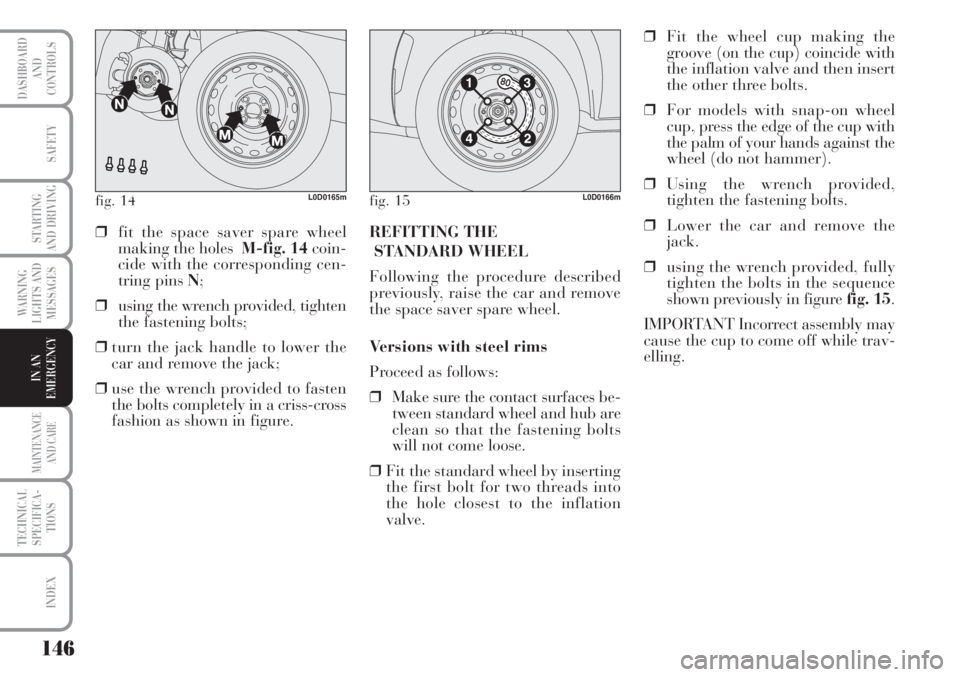
146
WARNING
LIGHTS AND
MESSAGES
MAINTENANCE
AND CARE
TECHNICAL
SPECIFICA-
TIONS
INDEX
DASHBOARD
AND
CONTROLS
SAFETY
STARTING
AND DRIVING
IN AN
EMERGENCY
fig. 14L0D0165mfig. 15L0D0166m
❒fit the space saver spare wheel
making the holes M-fig. 14coin-
cide with the corresponding cen-
tring pins N;
❒using the wrench provided, tighten
the fastening bolts;
❒turn the jack handle to lower the
car and remove the jack;
❒use the wrench provided to fasten
the bolts completely in a criss-cross
fashion as shown in figure. REFITTING THE
STANDARD WHEEL
Following the procedure described
previously, raise the car and remove
the space saver spare wheel.
Versions with steel rims
Proceed as follows:
❒Make sure the contact surfaces be-
tween standard wheel and hub are
clean so that the fastening bolts
will not come loose.
❒Fit the standard wheel by inserting
the first bolt for two threads into
the hole closest to the inflation
valve.❒Fit the wheel cup making the
groove (on the cup) coincide with
the inflation valve and then insert
the other three bolts.
❒For models with snap-on wheel
cup, press the edge of the cup with
the palm of your hands against the
wheel (do not hammer).
❒Using the wrench provided,
tighten the fastening bolts.
❒Lower the car and remove the
jack.
❒using the wrench provided, fully
tighten the bolts in the sequence
shown previously in figure fig. 15.
IMPORTANT Incorrect assembly may
cause the cup to come off while trav-
elling.